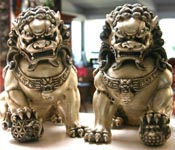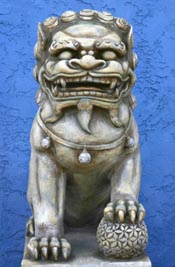Foo Dog History
Foo Dogs, Chinese guardian lions, are the ancient sacred dogs of Asia who have traditionally guarded palaces, temples, tombs and homes of the wealthy (see Wikipedia). The Foo Dog (lion dog) statues also make a strong statement and add style to any room, front porch or garden. These dogs have magnificent aesthetic appeal and a rich history of legend and tradition.
Foo Dogs can be traced as early as the Han Dynasty. Their first appearance was in Chinese art, which dates back to approximately 208 BC to about 221 AD. Foo Dogs vanished for nearly 400 years after their first appearance. They later returned in the T'ang Dynasty that was in power from 618 to 917 AD. Foo Dogs were popular because of their meaning.
There have been other theories that the name developed from the city of Foochow; however, there is no actual proof of this.
The lion is known as the proud master of the feline race. It is not indigenous to China, although lion artwork and sculptures were imported gifts to the Emperor. Foo Dogs have the appearance of a lion. The lion in Buddhist religion is seen as sacred, and has sometimes been offered to Buddha as a sacrifice. The name given to these guardians originates from China . The Chinese word for Buddha is Fo or Fu, which led to the original title – “Dog of Fo”.
Some Buddhist deities are occasionally depicted mounted on this beast. It is an emblem of valor and energy, those indispensable complements of wisdom, and embroidered on the court robes of military officials of the second grade.
These “dogs of Fo” or Foo dogs (Buddha's companions) are often placed at the threshold of temples, tombs, and even residences. The Foo Dog was the protector of sacred buildings and a defender of law.
Foo Dog artwork varied. Buddha was sometimes depicted on the back of the great beast, but Foo Dogs are more often displayed in a powerful guarding position. The creature is sometime presented holding a spear in its paw. This was the representation of the peace and serenity the animal would maintain for the sanctuary it was guarding; thus discouraging any wrong doers and demon spirits from entering the place of tranquility.
It is important to point out that the Foo Dog is also known as the Celestial Dog, and the Happiness Dog. The animal is a symbol of energy and value, and is often displayed in a male/female pair.
The Foo Dog pair is usually shown with the male holding one paw on a sphere symbolizing the Earth, while the female holds a cub. They come in many shapes, sizes, different materials, and colors. Their faces have a mischievous and almost devilish look about them; and their eyes are normally wide open with a tiny speck in the middle. This threatening appearance is what gives the idea that they guard against evil spirits.
The Foo Dog is embodied in rich Chinese history and tradition. They are still very popular today, not only in China, but also in other parts of the world. They are fantastic dogs not only infused with artwork – but with meaning.
A single, male Foo Dog currently guards the Island Beer Club during all meetings... So far, the evil spirits have been kept at bay.

